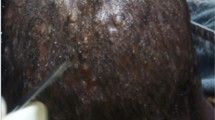Abstract
This study presents the epidemiological and mycological aspects of 299 patients with nail lesions who were referred to three diagnostic laboratories in the city of Cali. The diagnosis of mycoses was established through visualization of mycotic structures in a direct microscopic examination of skin scrapings and by isolation.
Onychomycosis was found in 183 cases (61.2%), of which 141 were in toenails (44 in males and 97 in females), 38 in fingernails (9 males and 29 females), and 4 cases in toenails and fingernails simultaneously (all females). No statistically significant relation was found between sex and onychomycosis.
Yeasts accounted for 40.7% of the mycoses, dermatophytes for 38%, nondermatophyte molds for 14% and the etiology was mixed in the remaining cases (7.3%). Candida albicans was the most commonly isolated yeast species; the most common dermatophyte was Trichophyton rubrum and Fusarium spp. and Scytalidium dimidiatum were the most common nondermatophytic molds.
Them common fungi found in fingernails were yeasts; in toenails dermatophytes were more prevalent (χ2 with Yates' correction = 19.75, P = 0.000088). Yeasts were observed more frequently in females while dermatophytes were more common in males. The difference between these two etiologic groups was statistically significant (χ2 with Yates' correction = 7.43, P = 0.0064); no relation was observed according to age.
Similar content being viewed by others
References
Rippon JW. Medical Mycology. The Pathogenic Fungi and the Pathogenic Actinomycetes. 3rd edn. Philadelphia, W.B. Saunders,1988:218–220.
Jain S, Sehgal VN. Onychomycosis: Treatmentperspective. Int J Dermatology 2000; 39: 10–14.
Vélez A, Linares MJ, Fernández-Roldán JC, Casal M. Study of onychomycosis in Córdoba, Spain: Prevailing fungi and pattern of infection. Mycopathologia 1997; 137: 1–8.
Mercantini R, Marsella R, Moretto D. Onychomycosisin Rome, Italy. Mycopathologia 1996; 136: 25–32.
Williams HC. Theepidemiology of onychomycosis in Britain. Br J Dermatol 1993; 129: 101–109.
Escobar ML, Vélez H, Santa Marýá L et al. Dermatomicosis y onicomicosis en estudiantes deunaescuelade policýá. Iatreia 1989; 2: 29–36.
Franco L, Villegas MC. Prevalencia dedermatotosisen unlaboratoriodemicologýá. Medicina UPB 1990; 9: 59–67.
Escobar ML, Ortega MC. Dermatomicosis. Análisisde 1044 lesiones diagnosticados en 1988–1989. Iatreia 1990; 3: 80–84.
González LA, Alvarez MI. Dermatotosis. Hospital Universitario del Valle, Cali, Colombia, 1978–1988. Colombia Médica 1991; 22: 14–18.
Rugeles MJ, Vásquez JL, Jaramillo E, Orozco B, Estrada S, Ospina S. Etiología y características clínicas dela onicomicosis en un grupo de pacientes in munosuprimidos. Infectio 2001;5: 7–13.
Correa I, Muvdi A, Loaiza T. Etiología de la onicomicosis enpoblación de Cartagena. Biomédica (Suppl.2) 1997; 17: 220.
Vélez H, Diaz F. Onychomycosis due to saprophytic fungi. Mycopathologia 1985; 91: 87–92.
Escobar ML, Carmona-Fonseca J, Santamaría L. Oni-comicosis por Malassezia. Rev Iberoam Micol 1999; 16: 225–229.
Escobar ML, Carmona-Fonseca J. Onychomycosis by common nondermatophemoulds. Rev Iberoam Micol 2003;20:6–10.
Rebell G, Taplin D. Dermatophytes. Their Recognition and Identication. University of Miami Press, Coral Gables, 1972.
Larone DH. Medically important fungi. Aguideto identication. Elsevier, 1987.
Zuluagade C.A, Tabares AM, Arango M, Robledo MA, Restrepo A, Lotero MC. Importancia crecientedelos géneros Fusariumy Scytalidium como agents de onicom-icosis. Rev Asoc Colomb Dermatol Cirug Dermatol 2001; 9: 593–599.
Gianni C, Cerri A, Crosti C. Non-dermatophytic onycho-mycosis. Anunderestimated entity? Astudy of 51 cases. Mycoses 2000; 43:29–33.
Pontes ZB, Lima E de O, Oliveira NM, Dos Santos JP, Ramos AL, Carvalho MF. Onychomycosisin João Pessoa city, Brazil. Rev Argent Microbiol 2002; 34:95–99.
Khosravi AR, Mansouri P. Onychomycosis in Tehran, Iran: Prevailing fungi and treatment with itraconazole. Mycopathologia 2000; 150: 9–13.
Gupta AK, Jain HC, Lynde CW, Mac Donald P, Cooper EA, Summerbell RC. Prevalence and epidemiology of onychomycosis in patients visiting physicians' offices: A multi center Canadian survey of 15.000 patients. J Am Acad Dermatol 2000; 43: 244–248.
Ghannoum MA, Hajjeh RA, Scher R, Konnikov N, Gupta AK, Summerbell R et al. Alarge-scale North American study of fungalisolates fromnails: The frequency of onychomycosis, fungal distribution, and antifungalsus-ceptibility patterns. J am Acad Dermatol 2000; 43: 641–648.
Tosti A, Piraccini BM, Lorenzi S. Onychomycosis caused by nondermatophyticmolds: Clinical features and response to treatment of 59 cases. J Am Acad Dermatol 2000; 42: 217–224.
Koussidou T, Devliotou-Panagiotidou D, Karakatsanis G, Minas A, Mourellou O, Samara K. Onychomycosisin Northern Greece during 1994–1998. Mycoses 2002; 45: 29–37.
Sais G, Jucgla A, Peyri J. Prevalence of dermatophyte onychomycosis in Spain: Across-sectional study. Br J Dermatol 1995; 132: 758–761.
Nsanze H, Lestringant GG, Mustafa N, Usmani MA. Aetiology of onychomycosis in AlAin, United Arab Emirates. Mycoses 1995; 38: 421–424.
Ng KP, Saw TL, Madasamy M, Soo Hoo TS. Onycho-mycosis in Malaysia. Mycopathologia 1999; 147: 29–32.
Banerjee U, Sethi M, Pasricha JS. Study of onychomycosis in India. Mycoses 1990; 33: 411–415.
Silva V, Moreno GA, Zaror L, de Oliveira E, Fischman O. Isolation of Malassezia furfur from patients with onycho-mycosis. J Med Vet Mycol 1997; 35: 73–74.
Segal R, Kimchi A, Kritzman A, Inbar R, Segal Z. The frequency of Candida parapsilosis in onychomycosis. An epidemiological survey in Israel. Mycoses 2000; 43:349–353.
Midgley G, Moore MK, Cook JC, Phan QG. Mycology of naildisorders. J Am Acad Dermatol 1994; 31: S68–S74.
Borkowski P, Williams M, Holewinski J, Bakotic B. Onychomycosis: Ananalysis of 50 cases and a comparison of diagnostic techniques. Jam Podiatr Med Assoc 2001; 91: 351–355.
García-Martos P, Domínguez I, Marín P, Linares M, Mira J, Calap J. Onicomicosis por hongos lamentosos no dermatotos en Cádiz. Enferm Infecc Microbiol Clin 2000; 18: 319–324.
Author information
Authors and Affiliations
Rights and permissions
About this article
Cite this article
Alvarez, M.I., González, L.Á. & Castro, L.Á. Onychomycosis in Cali, Colombia. Mycopathologia 158, 181–186 (2004). https://doi.org/10.1023/B:MYCO.0000041866.85314.e4
Issue Date:
DOI: https://doi.org/10.1023/B:MYCO.0000041866.85314.e4




